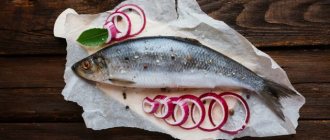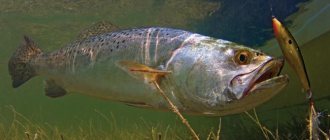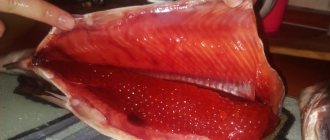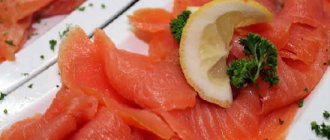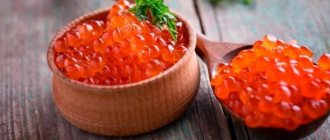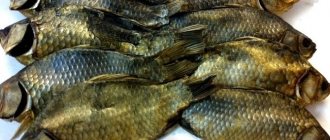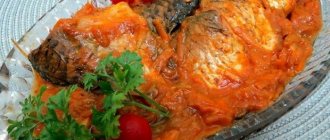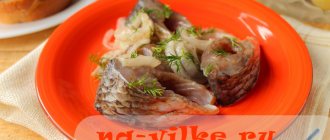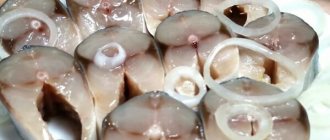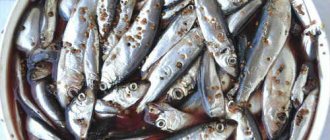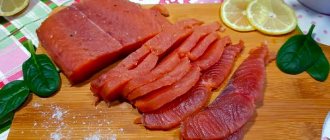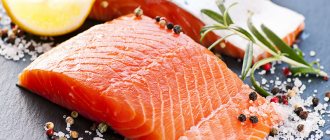If you want to try a new dish, be sure to cook a delicious fish - asp. There are many cooking recipes; if you wish, you can even make a delicious balyk from asp or simply bake it in the oven with a vegetable side dish. Whether this fish is bony or not, where to buy it, as well as what features need to be taken into account when cooking, recommendations from experienced housewives and cooks will tell you.
Brief description and cooking features
Asp is found in rivers flowing into the Caspian and Black Seas. Its meat is white, and the carcass itself is covered with a thin layer of silvery scales; on the back the color changes to gray. The maximum weight of an adult specimen can reach 10 kg, but usually individuals weighing up to 2-3 kg are put up for sale. The length does not exceed 80 cm. The fish is sold in markets, in seafood departments or in large supermarkets. The price is from 100 rubles per kg. Sometimes asp is sold in bulk, during the season, so you can look at wholesale stores, then the cost will be from 80 rubles per kg.
The meat turns out very juicy because it contains a lot of healthy fats. There are few bones, so cooking asp is not difficult. It is suitable for any purpose: the carcass can be fried, baked in foil or under a cheese crust, or dried. Due to its juiciness, the meat goes well with any side dishes: rice, vegetables, potatoes. To make the asp tasty, remember a few tricks when preparing it:
- Always remove the gills, they give a bitter taste when cooked. The scales are easy to clean off with a knife;
- take fresh fish, it tastes better than frozen;
- The maximum cooking time should not exceed half an hour. If you overcook the fat, the meat will not be as juicy;
- use spices and seasonings.
Cooking features
You can salt asp for subsequent drying or for use instead of lightly salted herring. The technology for preparing these snacks will be different. However, regardless of the chosen method of preparing this fish, the cook needs to know and take into account several important points.
- For salting, they usually use asp weighing from 1 to 3 kg, caught in the fall, since during this period it is the fattest.
- Before salting, the asp must not only be gutted, but also washed well, and then thoroughly dried with a napkin. It is especially important to do this if the fish will be salted dry.
- Choose coarse salt for preparing salted fish. It is important that it is not iodized, otherwise the snack will acquire an unpleasant aftertaste.
There are several recipes for salting asp. The choice depends on the purpose of salting and the gastronomic preferences of the cook. Salting time depends on the specific recipe and the size of the fish. In order to avoid mistakes and get the expected result, it is advisable to follow the recommendations that accompany the selected recipe.
How to fry properly
The easiest way to cook asp is to fry it in a frying pan with oil. It turns out very tasty and also quick. The recipe requires a minimum of ingredients, but you can add others.
- medium asp carcass;
- tsp salt;
- ½ lemon;
- spices;
- vegetable oil for frying.
Remove scales from the fish, gut the insides, and rinse with water. Remove the gills to prevent the meat from becoming bitter, or cut off the head altogether. Make shallow cuts crosswise on the sides with a knife, they are needed so that the meat is fried more evenly.
Blot the carcass with dry napkins to remove excess moisture, rub the outside and inside with salt and spices; cumin, rosemary, coriander, thyme, and ground black pepper work well. Squeeze lemon juice to neutralize fishy odor while cooking.
Add a little oil to the frying pan and heat it over medium heat. Once the surface is hot, carefully transfer the fish into the frying pan and fry on both sides until golden brown. The total cooking time takes 10-12 minutes. Then, as soon as the crust forms, cover the pan with a lid, turn the heat to low and continue cooking for another 5 minutes.
Blot the finished asp from the oil with napkins and serve hot with rice or a salad of fresh vegetables. Bon appetit!
How to pickle deliciously
Salted asp is not only a tasty dish, but also very healthy. The meat retains all the necessary microelements, and it dissolves in the mouth. It takes no more than 10 minutes to prepare.
- asp weighing up to 2 kg;
- 2 tbsp. table salt;
- tbsp granulated sugar;
- spices, dry herbs as desired;
- bay leaf – 3-4 pcs.;
- black pepper, peas – 3-4 pcs.
It is better to salt the fish using the “wet” method, then the meat is evenly salted. Take half a glass of boiled water, dissolve salt and sugar in it and add the rest of the ingredients.
Clean the fish from scales, cut off the head and remove the entrails. Rinse the carcass from blood clots and wipe dry with a towel. Transfer the asp to a large deep saucepan and fill with freshly prepared brine. If you want, you can salt it in pieces; to do this, cut the fish into large slices and remove the bones. The time spent on salting takes 8-12 hours.
When the time is up, drain the brine, rinse the fish under water, and place in a colander to drain off any remaining moisture. Cut into portions and place them on a plate. For beauty, drizzle with olive oil and garnish with sliced lemon slices and fresh herbs.
How to cook “Marinated asp”
Prepare the following ingredients.
Clean the fish from scales, remove the entrails and rinse inside and out. Cut off heads, fins and tails. Rinse the carcasses again and cut them into portions. Place the fish slices in a deep container.
Peel the onions and rinse them in water. Cut into half rings and add to the container with the fish.
Add salt and ground black pepper, add vinegar and odorless vegetable oil.
Thoroughly mix the entire contents of the container with slight pressure so that the marinade covers all the pieces. Denaturation of the protein in the pulp will immediately begin - white flakes will form. This is a normal process. Place the container in the refrigerator for 2 days, stirring its contents approximately 2-3 times a day. You can transfer the preparation to a jar or container with a lid to avoid fishy aroma in the refrigerator.
After two days, the appetizer will be completely ready - the fish pulp will absorb the salt and marinade.
Remove it from the container onto a plate or dish and serve chilled with bread or a side dish of potatoes.
How to cook awesome balyk from asp
True fish connoisseurs consider asp balyk a truly delicacy. You don’t have to bother much with it, since the recipe is simple, and the result will pleasantly surprise any gourmet. The tastiest balyk comes from a carcass weighing 1.5-2 kg, no less. Small individuals may be a bit dry.
- asp 1.5-2 kg;
- 100 g table salt;
- 3 tbsp. granulated sugar;
- spices (ground paprika, coriander, black pepper).
Clean off the scales, rip open the belly of the fish, take out the insides and thoroughly rinse off any remaining blood and remove the mucus. Cut off the head or remove the gills, cut the tail down to the very base. Take sharp scissors and cut the meat from the carcass: run the blade from the bottom of the abdomen to the ribs. This meat is considered more tender, so it is better to salt it separately from the whole carcass. Make a small incision on the spine.
In a separate bowl, mix spices with salt and sugar, sprinkle the mixture inside and outside the asp. Wrap it in gauze, you can take canvas or fabric. Tie the fish tightly with a strong thread, place it on a tray and put it in a cool place for 10 days. As salting proceeds, juice will accumulate in the pan; drain it periodically.
When all the time has passed, unwrap the fish, rinse with cold water and wipe dry. Before serving, brush with a little oil to give it a glossy, appetizing shine. You can store balyk for a very long time in the refrigerator, just put it in a container with a tight-fitting lid, otherwise all other products in the neighborhood will become saturated with the fishy smell.
If you happen to get your hands on an asp carcass, don’t miss the opportunity and be sure to use one of the suggested recipes, you definitely won’t regret it. This type of fish will certainly become one of your favorites, since cooking it is a pleasure, you won’t have to spend a lot of time fiddling around in the kitchen, and the dish will always be tasty and also very healthy.
We will also recommend you an amazing recipe for trout fish soup, tasty and appetizing!
Asp balyk is a very tasty and aromatic dish, so most housewives would like to learn how to cook it themselves. There is nothing difficult about preparing this product at home, you just need to know the technology.
How to cook balyk?
To flatten the carcass, use a sharp knife to cut along the entire length of the back, trying to separate the backbone from the fillet. It is better to do this on both sides of the spine. Cut off the ribs. Cut the ridge on both sides and remove it. Cut the head from the middle of the upper lip. Carefully remove all the insides. To dry fish, it is not recommended to wash it before salting.
Tips for fisherman: Asp balyk at home recipe - How to best use
Therefore, you need to carefully remove all blood clots with a linen cloth, paper napkins or any available material. The gills must also be removed.
Salt the asp thickly. It is better to use coarse salt for this, as it draws more moisture from the product; you can add a little sugar. First rub a little salt on the outside, and then sprinkle it thickly as well.
Next, you can do this in several ways: either place the fish in a hole or wrap it in cotton cloth.
If you salt a not very large asp in the wild, you can remove the insides by cutting the head under the gills. Remove the gills, rinse and salt inside, under the gill covers and outside. Place in plastic bags and roll tightly. Place it in a hole dug near the river bank or in another cool place and cover it with earth and tamp it down. The salting time for asp is at least 12 hours, but it can last from two days to a week. The fish, tied with a rope, will need to be re-tied as the moisture comes out.
In a well-salted asp, the flesh has a damp gray color, the back is dense, and it creaks when stretched.
Then the asp needs to be washed well, soaked in water for two to three hours and hung to dry for several days.
Ingredients. The recipe requires very little:
Characteristic
Asp is a European freshwater fish from the carp family. Usually has a length from 10 to 80 cm, some individuals reach 120 cm and weigh up to 12 kg. This type of fish inhabits lakes and lower reaches of rivers and estuaries. In the spring, in April-June, fish migrate from lakes to streams for spawning, which begins with an increase in temperature from + 6°C. Asp is caught in Estonia, Lithuania, Germany, Norway, Sweden, Finland, the Czech Republic, Poland, Ukraine, Bulgaria, Romania, Russia, Switzerland, Slovenia, the Netherlands and Belgium.
Adviсe
Balyk from this fish is famous for its fat content and pleasant taste; it slightly resembles pink salmon or chum salmon, which are more expensive. Experienced chefs give their advice on preparing salted asp.
- When salting, it is recommended to use any coarse salt, except iodized salt, since it gives the dish an unpleasant extraneous aroma. Salt allows you to quickly remove moisture from fish; it acts as a preservative that prevents the fish from spoiling.
- Fish weighing from 1 to 3 kilograms, caught in the autumn, are best suited for balyk. This is due to the fact that the asp at this time gains weight and becomes overgrown with fat, which is why the balyk from it turns out to be especially tasty.
- Before preparing balyk, you must first cut the fish and divide it into two halves. An incision is made from head to tail through the ridge.
- When removing the entrails, it is very important not to touch the gallbladder and remove the gills.
Cooking balyk from asp
Balyk from asp, recipe for cooking at home. How to prepare fish? How to pickle? How to marinate?
Asp is one of the most delicious and fatty fish living in Russian reservoirs. Especially the autumn asp. Of course, if we talk only about the amount of fat, then in sabrefish and even in bleak there is more of it in percentage terms. But asp has its own special taste and the best fish to make from this fish is balyk. How to cook it? This is what we will talk about.
Recipe for making balyk from asp
To prepare balyk from asp, it is best to use relatively large fish weighing about 2-3 kilograms. This asp is the fattest and tastiest, especially if, as already mentioned, it is caught in the fall. During this period, all the fish in our reservoirs, in preparation for winter, gain fat. The minimum threshold size of asp for preparing balyk is 1 kilogram, no less.
What will you need?
First, about the essentials for preparing asp balyk. First of all, of course, you need the asp itself. To pre-process it, you will need a knife with a strong, hard blade and a pointed tip. To salt fish, you only need coarse salt, which is generally used for salting any fish for drying and smoking. Next, you will need cotton fabric , or, in worst case scenarios, an old, clean sheet and a roll of twine, but not nylon. Everything should be natural.
Now you can begin the process of preparing balyk
First, we place the asp belly down on a flat surface of the kitchen workbench.
Then you need to make an incision, but not on the abdomen, but on the back along the ridge. You need to place the knife against the back of the asp near the head, with the blade towards the caudal fin. Make a puncture by hitting the handle of the knife. You need to pierce the carcass slightly to the side of the spine through the back into the abdominal cavity, but you must be careful that the knife does not touch the gall bladder or pierce the abdomen.
After a careful puncture is made from the back to the belly, the carcass should be cut along the spine, without touching the insides, and gutted. This must be done very carefully. Once you touch and pierce the gall bladder, the fish will taste bitter. In fact, we can say that the fish in this case will be spoiled, even if the insides are washed.
The next step will require salt
We pour handfuls of it into the cut we made, carefully salting the belly from the inside, not forgetting to pour salt into the gills. Next, we lay the carcass on its side and begin to rub salt into it, always against the scales. There is no need to be afraid to use large amounts of salt; you don’t have to skimp on it. After salting, the fish will still be soaked, but the asp must be properly salted, especially if it is large. Otherwise, the fish may spoil or there will be a risk of infection with various fish parasites and worms. You should also carefully salt the belly under the fins. Firstly, these are difficult to reach and dense places, and secondly, the fleshy fins themselves are tasty at the base.
Then the carcass must be laid diagonally on a cotton cloth or sheet measuring one meter by one meter. And here begins an important operation , obviously similar to bandaging mummies. This requires tight winding. To do this, you need the help of someone in the household. An assistant will need to pull the fabric towards you from the opposite side. The carcass is wrapped tightly in fabric, then wrapped just as tightly with twine, starting from the loop on the asp’s head. The distance between the turns of twine should not exceed 3 cm. If the winding is weak, it is better to go back, making the turns of twine overlap the previous ones.
After this, the “doll” must be placed on film and kept at room temperature for a day, turning it from side to side from time to time. After the “doll” gets wet from the extracted brine solution, it must be placed in the lower section of the refrigerator, where it can now be stored as long as needed.
But we need a balyk!
Therefore, after a week, you can remove the carcass and wash it thoroughly , then insert sticks into the cut and under the gill covers and let the fish lie in the water for about 7 hours, changing the water at least twice.
Then all that remains is to drain the water from the abdomen and hang the carcass “unfolded” in a cool place. And in a few days the amber-fat balyk from asp will be ready. Bon appetit!
Preparation
Before you start salting the fish, you need to prepare it. To do this, do not touch its scales, since they act as a frame for the meat, but the insides are completely removed. This is much easier to do over a sink with a faucet. The fish is taken by the tail, lowered head down, then the belly is ripped open from the caudal fin to the head. The knife should not be immersed too deeply, otherwise you can cut not only the gallbladder, but also the esophagus, and in this case the meat will smell unpleasant, and you will have to wash the carcass for a long time.
This is done if two parts of the fillet are cooked separately, but if you want to preserve the integrity of the asp, then an incision is made not on the belly, but along the ridge, the head is divided in half, as is the tail.
Salting
You cannot begin the main process unless you first salt the fish, because then it will simply dry out. You can take a concentrated liquid brine: for one liter of water use 100 grams of salt, which will need to be dissolved in the liquid. To do this, place the pan on the fire and bring to a boil. You can put:
- peppercorns;
- Bay leaf;
- cloves;
- sugar;
- fresh or dried herbs.
When the brine has cooled, the fish is immersed in it for 8-12 hours, depending on its weight.
You can use dry salt; to do this, simply mix it with spices and add it to the fish. To speed up the process, a weight is placed on top, which helps the juices come out. Some people prefer to salt the whole thing for drying, but in this case the process takes longer because the preservative must penetrate inside. You can do this in pieces by cutting the fish into steaks.
Spicy-salted asp is very popular (as is herring). In this case, bay leaf, black peppercorns and cloves are boiled in salted water. They give off their aroma first to the brine, and then to the fish. This marinade is also suitable for hot smoking.
Proper salting helps create a dish that is not only tasty, but also safe for human health, so this stage should be given more time and attention.
Preparation
After the fish has spent the required amount of time in the salt solution, it must be rinsed well and placed on paper towels to absorb moisture. After this, you can hang the carcasses on the street or balcony, the main thing is that the room is well ventilated.
Protection against insects will be gauze, which is pre-moistened in vinegar and then covered with fish. Once a day you will have to wet it again. If this is not done, the flies will lay their larvae on the fish, worms will appear, and the product will not be edible.
To reduce cooking time, you can turn on the fan. Balyk is prepared over several days in hot weather; in any case, you will need to periodically check the readiness of the product.
Salting asp for balyk in brine
- Cut the asp along the back, leaving the skin on the belly intact.
- Remove the entrails from the fish and rinse the carcass well.
- Place the asp in a container.
- Boil water in a small saucepan and add salt. Boil for 5 minutes. Allow the brine to cool to room temperature.
- Pour brine over the fish, cover with a plate, place a weight (for example, a jar of water) and put it in a cool place.
- Keep the fish in the brine for 8-12 hours. If it weighs more than the recipe calls for, increase the salting time.
To obtain balyk from an asp, it must be soaked in clean water for several hours, then wrapped in gauze soaked in vinegar to protect against insects and hung in the shade. It takes 1-2 days to dry a kilogram asp; larger specimens will also require more time.
Salting caviar
Salting caviar is as easy as preparing balyk. According to the recipe for a lightly salted dish, you will first need to remove the film; for this you can use a large sieve through which you can simply wipe it.
Then take 20 grams of salt, 10 grams of sugar per 100 grams of caviar and add it to sleep. If desired, you can use dry herbs or spices, but this will be unnecessary. Mix everything well, put it in a glass jar, close the lid and put it in the refrigerator for a day.
You can spread the product on bread with butter and enjoy its amazing taste.
To learn how to pickle asp, watch the video below.
Spicy salted asp or “Herring from asp”
After the summer and autumn seasons, at the beginning of winter, the asp, having gained fat for wintering, becomes a very tasty fish. I noticed that many of our amateur fishermen really like to catch asp in the autumn and spring. But not everyone takes it home after fishing, because they don’t know what to cook from it or are too lazy to clean it, citing the fact that they don’t like to eat asp. But in vain...
You've probably heard, and many may have even tried or made your own “herring from asp”. And some people generally do not perceive asp in gastronomic terms as a tasty fish, considering it very bony. For me, asp is one of my favorite types of fish in culinary delights. Since it is a predator, it does not have such a pronounced fishy smell and I like this most of all. From asp I prepare several types of dishes: Heh and cutlets from the back of asp fillet, fried asp of various types, panchani from asp, marinated asp, chebureki from asp, as well as herring.
I want to share with you my recipe for making “asp herring”. The recipe is not at all complicated, even the laziest or least experienced person can easily make this dish.
Based on 1 liter of brine:
bay leaf - 3 pcs.
coriander - 0.5 teaspoon
1. Place a pan on gas with the volume of water that you will need for the fish. Add all the spices at once and bring to a boil. As soon as it boils, turn down the gas a little and let the brine simmer for another 5-7 minutes. Leave the brine until it cools completely.
2. Asp fish, preferably specimens up to 1.5 kg.
Clean the fish from scales, gut it from the inside and separate the head, cut off the fins and tail, rinse with cold running water. You will get a beautiful, clean asp carcass. Blot each carcass from excess moisture with a napkin.
3. Place the fish in an enamel or plastic bowl and pour chilled brine over it. Place a pressure on top so that the brine completely covers the fish. Place in the refrigerator or cool place for 4-5 days.
4. When the fish is salted, take it out of the brine and separate the fillets and remove the skin (if there are fans of herring with bones and skin, then you don’t have to do this). Cut the fish into pieces 4 cm wide, onion into half rings or rings and place in layers (layer of fish + layer of onion + pour oil, layer of fish + layer of onion + pour oil and so on, filling the container to the top) in a glass jar or plastic food container , between layers, generously water with vegetable oil, pepper - your choice. Close the lid tightly and put it in the refrigerator for 2-3 days. During this time, the fish will be well soaked in oil and onion juice, which will give it tenderness and melt in your mouth.
What and how to cook
To obtain a subtle, pleasant taste, you will need:
- two large herring carcasses;
- 1 tbsp. spoons of salt and 1 teaspoon of sugar;
- 2.5 glasses of water.
After preparing the herring, it is placed in a container. Salt and sugar are poured into boiling water, after which the marinade cools to room temperature. After this, the herring is completely filled with this solution, covered and moved to a cold place (refrigerator) for a couple of days.
Recipes for quick salting at home
This simple recipe does not contain exclusive ingredients, especially since it does not require much time to prepare. The herring is defrosting, but not completely. The carcass is removed from the giblets, skin and bones. The herring fillet is cut into several parts and placed in a prepared container.
Preparation of brine:
- take 3 heaping tablespoons of salt;
- half a liter of cool water;
- Herring pieces are completely filled with brine. After an hour and a half, the brine is drained.
Further actions:
- you need to take 250 ml of cold water;
- 1 tbsp. spoon of 9% vinegar;
- pieces of herring are poured in for five minutes, after which the liquid is drained again.
The following ingredients are added to the herring:
- onion;
- Bay leaf;
- black pepper, peas;
- sunflower oil;
- pieces of herring are poured for half an hour.
Whole herring in brine
To salt 1 carcass you need the following:
- 1 liter of water;
- 3 tbsp. spoons and 1.5 tsp sugar;
- 5 black peas and the same amount of allspice;
- 2 pcs bay leaves;
- 3 buds of cloves.
All ingredients are placed in a vessel and brought to a boil. The solution must be cooled. After this, the herring carcass is placed in a container and filled with cooled marinade. The container is selected so that it is possible to fill the herring entirely. After this, the product is placed in the refrigerator for two days.
Salting without water in oil, in pieces
Based on the calculation, the following quantity of products is taken for 1 kg of herring:
- onions – 0.5 kg;
- salt – 3 tbsp. spoon;
- refined sunflower oil – 5 tbsp. spoons
The herring carcass is butchered and cut into pieces. Each piece is rubbed with salt and placed in a container. The onions are cut into rings and placed on top into pieces. Each layer of herring is formed in a similar way. Finally, the fillet pieces are filled with vegetable oil. Cover the product with a lid and put it in the refrigerator for a couple of days.
Don herring, salting features
This type of herring is considered the fattest and most delicious fish. As a rule, it is salted in large quantities for the winter.
To prepare the brine, take 100 g of salt per 1 liter of water. The herring is placed in a separate container and filled with solution. The fish is pressed from above with a special oppression. This is necessary to ensure that the fish is constantly in brine. After this, the herring is placed in a cold place for about 5 days. When salting, it is not recommended to add various spices, as they can overwhelm the taste of the fish itself. Many people claim that if you take water from the Don River, the herring turns out to be especially tasty.
Lightly salted herring in a jar
The recipe is designed for preparing two large carcasses of fresh frozen herring:
- you should take 0.5 liters of water;
- 3 tbsp. spoons and 2 tbsp. spoons of salt and sugar, respectively;
- spices (bay leaf and allspice).
Quick fried asp
The easiest way is to fry fish. It won't take you much time. It is advisable to fry small carcasses. If you have a large asp, cut it into portions. Fried asp is also tasty cold.
On a note! Asp is a fairly fatty fish, and it produces a tasty and rich fish soup.
Compound:
Preparation:
- Let's prepare the fish: clean it, cut off the heads. Then we cut the belly and take out the insides. And now the asp needs to be thoroughly washed. Make sure there is no black film left inside.
- Salt the asp and sprinkle with ground pepper outside and inside. Leave for half an hour.
- Sift the flour into a deep bowl and roll the asp in it.
- Heat the vegetable oil in a frying pan.
- Fry the asp on each side for 10-15 minutes. The fish will be covered with a beautiful golden brown crust.
- Place the asp on a plate and let it cool slightly.
- In the meantime, wash the green onion and finely chop it with a knife.
- Sprinkle fish with onions before serving.
Attention! There are a lot of small bones in the asp, so it is not recommended to give this fish to small children.
Quick salting asp
- asp – 1.5 kg;
- water – 1 l;
- apple cider vinegar (6 percent) – 20 ml;
- salt – 40 g;
- sugar – 20 g;
- laurel leaves, pepper, mustard seeds - to taste.
- Clean the asp. Rip open the belly of the fish and remove the entrails. Trim the meat from the spinal bone. Cut the fillet into slices 2-3 cm thick. Place in a liter jar or container.
- Boil water, pour salt, sugar into it, add spices, focusing on your taste.
- Boil the brine for 10 minutes. Pour vinegar into it and stir. Remove from heat immediately.
- Allow the mixture to cool to 35-40 degrees, pour it over the asp pieces.
- After an hour, put the container with the asp in the refrigerator, having closed it first.
After 12 hours, the asp, salted according to this recipe, will be ready for consumption. It tastes like preserves. If you double the amount of vinegar and leave the asp to salt for 24 hours, the bones in it will soften, making it much more pleasant to eat.
When serving salted asp, it doesn’t hurt to sprinkle with chopped onions, pour over vegetable oil, and garnish with sprigs of herbs or lemon slices.
Baked fish with delicious sauce
Asp is quickly and easily prepared in the oven. To make the fish juicy, bake it with sauce. And in order not to waste time and energy on cutting up a fish carcass, buy ready-made fillets.
Compound:
Preparation:
- Wash and dry the fish fillet.
- Beat one egg into a deep container and add salt.
- Beat the resulting mixture until smooth.
- Dip the asp fillet in the egg mixture and then in breadcrumbs.
- Fry it on all sides in vegetable oil until the fish is covered with a golden crust.
- Grind the cheese and mix with the remaining egg.
- Let's introduce a blend of spices, sour cream, 1 tbsp. l. breadcrumbs and salt. Stir the sauce until smooth.
- Heat the oven to a temperature of 190 degrees.
- Place the asp fillet on a baking sheet and pour over the sauce.
- Bake the fish for half an hour. Ready!
Asp with mushroom notes
This dish is interesting because in addition to the fish, we immediately prepare a side dish. You can use any river fish, and also complement the taste of the dish with your favorite vegetables.
Compound:
- 1 kg asp;
- salt;
- ground pepper;
- 5-6 tbsp. l. mayonnaise;
- 2 pcs. Luke;
- 0.5 kg of mushrooms;
- 2-3 tbsp. l. refined vegetable oils;
- carrot;
- 0.7 kg of potatoes;
- greenery.
Preparation:
- Peel one onion and chop it into thin half rings.
- We clean and wash the asp. We make cuts on the fish and put the onion in them.
- Salt and pepper the asp, coat with mayonnaise.
- Let the fish marinate for a couple of hours.
- Peel the carrots and potatoes, rinse and cut into thin circles.
- Peel the mushrooms and the remaining onion and chop finely.
- Fry the mushrooms and onions in vegetable oil until tender.
- We fill the asp with mushrooms.
- Place the asp on foil and distribute carrots and potatoes around.
- Bake the fish with vegetables in foil for forty minutes at a temperature of 190-200 degrees.
- Serve the asp with vegetables, sprinkled with chopped herbs.
Asp balyk at home
Are there any friendly get-togethers planned? Prepare balyk from asp. It will be an ideal snack for a foamy drink.
Compound:
- 1 kg asp;
- 1.5 kg table salt;
- 1-2 tbsp. l. refined sunflower oil.
Preparation:
- There is no need to clean the asp when preparing balyk. We wash the fish and cut it along the ridge. We do not remove the tail and head, but rather cut it.
- We clean the insides and cut off the gills so that the balyk does not taste bitter and is well salted.
- We wash the asp carcass again and soak it in cold water for an hour.
- Now we wash the asp again and dry it with a kitchen towel.
- Place the asp in a baking tray or on a flat dish, scales down, and make cuts along the carcass with a knife.
- Cover the carcass with salt and leave for half an hour. Then rub in the salt thoroughly.
- We take a convenient container so that the asp fits completely in it, and pour salt into the bottom.
- Place the asp on top, again with the scales down, and cover it with salt.
- Let's put a not too heavy load and put the fish in the refrigerator for 12 hours.
- Now we need to soak the asp.
- We rinse it with running water, then fill it with clean water and leave for half an hour.
- Then drain the liquid and repeat this algorithm 2-3 times.
- We hang the asp carcass so that the moisture evaporates.
- Lubricate the fish with sunflower oil and fold it in half. It will look as if it was never cut at all.
- Wrap the asp in parchment paper and place it in the refrigerator. Balyk is ready!
Balyk from ide, simple recipe
Balyk from asp turns out to be as rich as balyk from ide. The recipe for “Yazevsky” balyk differs little from “Zherekhovsky”.
The described cooking method is the most economical and fastest.
Ingredients. In this case, there will be even fewer components than in asp balyk:
- 1 fish – 1.5 – 1.8 kg.
- Coarse table salt - 200 grams.
- Sugar – 15 grams (optional).
- ¼ lemon (also for everyone).
Let's cook. The procedure for salting is as follows:
How do you prepare zherich, ide, and bream at home? Share in the comments.
We lay out the fish with the scales down; if the fish is large, then we make a notch in the flesh with a knife for better salting and fill it with salt from the heart. Don’t be afraid to overdo it; it’s better to over-salt and then soak the fish than to under-salt and throw away a tasteless product! My asp lay in this state for about 15 minutes; large specimens should be under a salt bed for up to an hour. Then rub the remaining salt into the fish.
We lay out the fish with the scales down; if the fish is large, then we make a notch in the flesh with a knife for better salting and fill it with salt from the heart. Don’t be afraid to overdo it; it’s better to over-salt and then soak the fish than to under-salt and throw away a tasteless product! My asp lay in this state for about 15 minutes; large specimens should be under a salt bed for up to an hour. Then rub the remaining salt into the fish.
Take a container of suitable size. In my case, this is an enamel tray from my grandmother's very old refrigerator. You can take all kinds of basins, including plastic ones. Pour a lot of salt onto the bottom of the container, transfer the unfolded fish with the scales up and again cover it with a layer of salt on top. The salt should cover the entire fish completely, do not forget to sprinkle the head thoroughly, it should also be salted. In total, it took me about one and a half kg of salt for this weight of asp, so stock up on it in advance.
We place the fish under slight pressure so that it is pressed to the bottom of the container, but not flattened into pieces). When the asps were larger, I used dumbbells as pressure, but for such a specimen a small weight is quite enough.
Tips for fisherman: Tackle for catching asp on a spinning rod - What to choose for fishing
So the fish hangs for an hour, draining and getting a little weathered. Again, without the participation of flies. And here it is - the finished balyk!
Lightly grease the surface with vegetable oil, fold it in half as the fish originally looked, wrap it in thick paper (or newspaper, in extreme cases) and put it in the refrigerator, putting something purely symbolic on top as a pressure - an oil dish, a bag of vegetables or milk – so that the meat thickens and looks prettier.
All! I made it last night and can use it today. A couple more comments. The scales are cleaned by each taster independently, this is such a ritual, the tattered balyk laid out for guests by the hostess looks sad. It’s better to take care of the supply of napkins and give everyone this pleasure - to peel the scales off their own piece. If you don’t like balyk with beer, try it with boiled potatoes – it’s also delicious!
- asp – 2-2.5 kg;
- granulated sugar – 125 g;
- coarse salt – 250 g.
How to make balyk from asp in Astrakhan - a recipe at home
Ingredients:
- asp – 2-2.5 kg;
- coarse salt – 250 g.
Preparation
As time passes, we place the dried carcasses in the sun or place them in a warm place and, as soon as droplets of fat appear on the surface of the balyk, fold it in half, place it in a bag and place it on the refrigerator shelf for a day to evenly redistribute moisture. After this, you can try the finished asp balyk.
Balyk from asp - recipe with sugar
Ingredients:
- asp – 2-2.5 kg;
- granulated sugar – 125 g;
- coarse salt – 250 g.
Preparation
We blot the soaked workpiece with a towel or napkins and hang it in a ventilated place to dry and dry for several days. Before eating, you must first keep the fish in the sun for several hours to separate the fat, then wrap it in paper and put it in the refrigerator for a day. Now you can try the asp balyk. Bon appetit!
You can take a sample from the snack after 24 hours. It has a sweet and salty taste, which will appeal to lovers of Asian cuisine.
- asp – 1.5 kg;
- water – 1 l;
- salt - how much will be needed;
- potatoes - 1 tuber;
- hot red pepper – 10 g.
Balyk made according to this recipe will appeal to lovers of spicy snacks.
Balyk, made from asp, has a unique taste and its organoleptic qualities resemble red fish. You can make this snack at home. Even a housewife who does not have much culinary experience can cope with this task.
Clean the fish from scales, cut off the head and remove the entrails. Rinse the carcass from blood clots and wipe dry with a towel. Transfer the asp to a large deep saucepan and fill with freshly prepared brine. If you want, you can salt it in pieces; to do this, cut the fish into large slices and remove the bones. The time spent on salting takes 8-12 hours.
Juicy cutlets from the oven
Try baking cutlets from asp and minced meat. They are delicious and incredibly healthy! This dish will please everyone in your household.
Attention! While baking the cutlets, add broth or filtered water to the pan if necessary.
Compound:
- 0.3 kg minced meat;
- 150 g white bread;
- 0.5 kg asp fillet;
- 2 eggs;
- onion;
- 2 tbsp. l. refined vegetable oils;
- salt;
- milk;
- ground pepper.
Drying the asp correctly
So that our dried asp does not turn out too dry, but is well dried, we hang it on a string in the shade, in a dry and well-ventilated place. In an apartment, an unglazed balcony or loggia with wide open windows is suitable for these purposes. In a private home, you can safely hang fish in the shade near the house. Make sure that the asp is not wetted by precipitation and that flies and other insects do not land on it. It is best if there is a canopy over the fish, and the ropes with the asp themselves can be hung on the sides with gauze. After two weeks of drying, smaller asps will be ready, but large specimens should be dried longer.
Salted asp is a real fish delicacy. It's easy to prepare. The dish will turn out so tasty that it will become your favorite. A simple and affordable recipe for your attention.
To salt asp at home, we need a minimum food set. We are sure that every housewife has it in the kitchen.
Ingredients:
- raw asp carcasses - at least 2 kg;
- onions - 1 kg;
- salt (necessarily coarsely ground) - a pack;
- sunflower oil - 250 ml;
- peppercorns, black - 15 pcs.;
- bay leaf - 2 pcs.;
- ground pepper - to taste.
Now that all the ingredients are prepared, we begin to salt the fish. To do this, we carry out the following steps:
- We clean the asp thoroughly and carefully. Let's gut it carefully. Cut off the head and tail. You can make a rich soup from them.
- The prepared fish is cut into medium pieces. Then they must be cut in half, otherwise the fish will be salted unevenly and will disappear. There is no need to separate the bones and skin from the fish. They will give the salted asp an additional, more piquant taste.
- Each piece obtained should be salted generously and evenly. The easiest way to do this is to simply grate the fish.
- The grated fish is left indoors for 4 hours. Do not put it in the refrigerator under any circumstances, otherwise the chemical processes will stop and the fish will not be salted within a given period of time.
- As soon as the specified time has passed, each piece is individually washed under running water. As a result of the manipulations, the asp should be completely free of salt.
- The onion is peeled, washed, cut into rings.
- We select a glass jar with a volume of one liter. It is advisable to sterilize it first.
- We will place the fish with spices in layers in this container. It happens like this: onion, a piece of fish, ground pepper, bay leaf, and so on until the last piece of asp fits.
- Pour the fish mass generously and evenly with sunflower oil. We put it in the refrigerator. Literally the next day you can safely eat fish. It is completely ready for consumption. To further emphasize the taste properties of the salted asp, it is recommended to pour a small amount of lemon juice over it.
The best recipes for making balyk from asp
There are many recipes for making asp balyk at home. Each of them allows you to make an original dish with exquisite taste. Individual ingredients give the product an unsurpassed aroma, and the subtleties of salting and drying make it possible to obtain a juicy and tender balyk.
Asp in Astrakhan
Astrakhan is a region famous for fishing. Rich catches have led to the fact that residents began to create original recipes with which everyone can prepare delicious dishes without much effort. For 3 kg of asp you will need 300 grams. salt.
The step-by-step instructions look like this:
- The fish is cleaned and cut.
- Soak the carcass in ice water and dry.
- Make cuts where the meat is thick.
- Rub the fish with salt on all sides.
- Place the product under pressure and place in the refrigerator for 12-15 hours.
- Soak the salted fish in water for an hour.
- Hang out the balyk for drying.
This asp will delight you with its taste, and it will also have an attractive golden crust if you hang it in the sun for a while.
Sugar balyk
This recipe is similar to the previous one, but you will need to include sugar in the ingredients. It will help make the dish taste exquisite, and it also helps the salt penetrate deeper into the fibers. For a fish weighing 3 kg you will need:
Balyk is prepared according to the following algorithm:
- The fish is cleaned, washed and cut into pieces if the carcass is too large.
- The fillet is rubbed on all sides with salt and sugar.
- The meat is placed in a container and placed under pressure.
- The container goes into the refrigerator for 4-6 days.
- The fillet is washed under running water for 1 hour or soaked in cold water for 4-5 hours.
- The asp is wrapped in gauze and placed in a ventilated room or outdoors, but not in the open sun.
The duration of drying depends on personal preference. If the balyk should be dry, it will take about a week, but for a juicy and soft product, 4 days will be enough.
In this case, you should periodically check the meat for readiness, since the speed of drying depends on external conditions.
Wet pickling recipe
This recipe is often used when traveling. It is also used when subsequent smoking is planned. A strong saline solution - brine - is prepared using exclusively salt, sugar and water. But in some cases, spices are added to taste to make the fish with a piquant aroma. To check the readiness of the brine, dip a raw egg into it. It should float to the surface.
The asp is placed in brine and placed under pressure. You can pre-string carcasses or pieces onto twine. This will make further drying and smoking at home easier. To salt balyk from asp, it will take from 3 to 5 days.
After salting, the fish is washed for about 30-60 minutes and hung for airing.
Carcass preparation
First of all, the fish should be thoroughly washed to remove mucus in cool water, preferably running water. Then you can start cutting.
- Conveniently place the asp on a cutting board and remove the scales, holding it by the tail. After this, make a cut along the ridge from the tail to the head.
- Separate the meat from the bones of the ridge on one side and try not to damage the abdomen.
- Lay the carcass out like an open book and carefully remove all the insides with the backbone and bones.
- Remove the gills with eyes from the head and rinse again in cold water.
- After it has dried, you can start cooking.
Fish caught in summer and autumn are best suited for making balyk. This is due to the fact that in winter and spring its meat does not have enough fat and is dietary.
Salting the carcass
Every fisherman and housewife has their own salting secrets. But how to make balyk from asp without knowing them? However, it's quite simple. It is enough to know 2 methods of salting, they are the main ones.
- Dry salting method. You need to take coarse rock salt and generously rub the prepared asp on all sides. You need to rub the carcass so that the salt penetrates into each fold and is fixed in it. After this, the fish must be placed under oppression for 12 hours. Then they can be taken out and cleaned of excess salt by rinsing and soaking in clean water.
- Salt in brine (brine). This method requires a saucepan. You need to pour the required amount of water with salt into it and boil it. You can use peeled potatoes to check the concentration. If it floats up, then there is enough salt. After the brine has cooled, the prepared carcasses are immersed in it and left in the refrigerator for 12 - 14 hours. Afterwards, the asps are taken out and then soaked in plain water.
After completing all the steps of salting and soaking, they proceed to the drying process.
Balyk from asp
Asp is an unusual fish. She prefers to live in lowland rivers, but absolutely cannot stand standing water. It has no teeth, but at the same time it feeds, like a real predator, on insects, fry, and plankton. The asp is also a master at hunting: the fish stuns its prey with a blow of its tail and then eats it. This is exactly the kind of cunning prey we will be preparing today.
Cutting asp into balyk
The recipe for balyk from asp requires thoughtfully choosing the fish for it and no less thoughtfully approaching the issue of cutting it. Firstly, not every asp is suitable for preparing tender, aromatic balyk: if caught in winter or spring, the asp will be completely dietary. This fish gains its main fat in the summer, and the best asp for balyk is caught in late summer and autumn. Secondly, the weight of the fish plays an important role. An asp can, of course, grow up to 12 kilograms, but catching such a giant is not an easy task. Most often, the weight of this fish is from 1.5 to 2 kilograms. It is this kind of asp that is best salted, and it makes an excellent balyk.
So, we take a carcass weighing about 2 kilograms. Before making balyk from asp, the fish must be properly cut - in cooking, this technique is called layering, that is, all the meat must be removed in one layer. To do this, use a sharp wide knife to make a long cut along the entire back of the fish along the ridge from head to tail. We separate the ridge from the ribs on one side and lay out the fish like a book. Carefully remove the entrails, ribs, and gills. After this, rinse the resulting layer thoroughly with cold water.
Preparing the fish
The recipe for asp balyk requires a minimum of ingredients: by and large, you only need fish and salt. By the way, it is better to take large, non-iodized ones. Fans of spices can also add seasonings to their taste - dried fennel, dill, oregano. The finished plated carcass needs to be salted. Salting of asp can be done either in a dry way - simply rub it thoroughly with salt inside and out, or in a salamur brine. For this, boil water and salt in a container. The calculation of salt is determined simply: raw potatoes should not sink in the prepared brine. Spices are added either with salt or boiled in brine.
The asp is salted for about 8-12 hours. In the case of dry salting, you can leave it under pressure. But after this, our fish needs to be washed and soaked from excess salt, and the larger the fish, the shorter the soaking time: from one and a half hours for a large asp under 3 kilograms to 3 hours for kilogram specimens.
Drying asp
Each balyk must be straightened and all liquid allowed to drain. Afterwards, you need to straighten the bellies on the carcasses and insert spacers (it is best to use wooden sticks) and wrap them in gauze. This way insects will not be able to spoil the future delicacy. If you have a special mesh dryer, you can use it.
After this, you should choose the most suitable place for hanging. It should be cool and well ventilated. In this state, the balychki dry for 2–3 days. It is better to put them in the refrigerator at night.
In order to give the meat a golden hue, after drying, the carcasses should be laid out in the sun for 60 - 90 minutes. The fat that appears on the meat will give the desired and incomparable appearance. After this, the balyk is ready.
Recipes for cooking balyk
Asp balyk can be quickly prepared at home using popular recipes.
Asp in Astrakhan
This treat should be made from the following products:
- 2.5 kg asp;
- 250 g coarse salt.
Fishermen recommend using step-by-step instructions.
- Take a fish carcass weighing at least 2.5 kg and prepare it for use.
- Soak in ice water for 25 - 35 minutes and then dry.
- In areas where there is most meat, make shallow cuts.
- Rub the carcass with salt on each side and make sure that the salt gets into the cuts.
- Place the semi-finished product in an enamel container of suitable depth, place a dish on the carcass and apply pressure.
- Remove everything from the refrigerator for 12 - 15 hours.
- After the time has passed, take out the salted balyk and soak it in cold water for 45 - 60 minutes.
- After this, prepare for drying and hang in a suitable place.
Don't forget to brown the asp in the sun to give it an appetizing appearance with a golden hue.
How to pickle asp at home
Asp is a predatory fish of the carp family. It can be prepared in many ways, but most often it is salted and dried. Balyk ikh nego is an ideal snack for beer, but is also tasty on its own. Cooked in a spicy brine, it is similar to herring and goes well with boiled potatoes. If you managed to get the said fish, first of all you should find out how to salt an asp at home. Of course, you can fry or bake it, but still you should definitely try it in its salted form.
